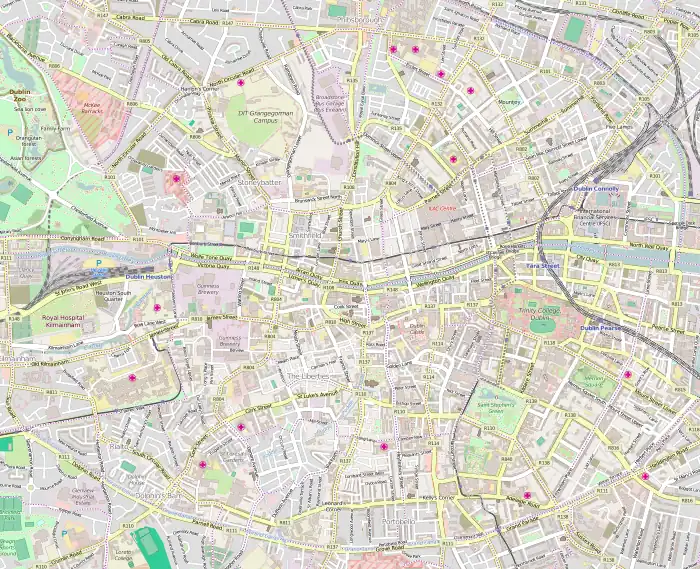Meath Hospital
The Meath Hospital (Irish: Ospidéal na Mí) was a general hospital in the Earl of Meath's Liberty in Dublin, Ireland. It was absorbed into the Tallaght Hospital in June 1998.
| Meath Hospital | |
|---|---|
| Health Service Executive | |
 Meath Hospital, now a respite home | |
 Shown in Dublin | |
| Geography | |
| Location | Dublin, Ireland |
| Coordinates | 53°20′09″N 6°16′11″W |
| Organisation | |
| Care system | HSE |
| Type | General |
| History | |
| Opened | 1753 |
| Closed | 1998 |
History
The hospital was opened to serve the sick and poor in the crowded area of the Liberties in Dublin in 1753.[1] It then moved to larger premises in Heytesbury Street in 1822.[2]
In the nineteenth century the Meath Hospital achieved worldwide fame as a result of the revolutionary teaching methods and groundbreaking research carried out by Robert Graves and William Stokes, physicians of the hospital. One example was when during a typhus epidemic Robert Graves introduced the revolutionary idea of giving food during the illness ("he fed fevers" was what Graves requested be inscribed on his tombstone).[3]
It was absorbed into the Tallaght Hospital in June 1998.[4] The original building was subsequently converted for use as a respite home.[5]
Notable physicians
Notable physicians included:
- John Cheyne (1777–1836), appointed a physician in the hospital in 1811.[6]
- Sir Philip Crampton (1777–1858), appointed surgeon to the hospital in 1798 (though not fully qualified).[7]
- Patrick Harkan, of Raheen, County Roscommon, appointed a physician in the hospital in 1817. He later went on to the Cork Street Fever Hospital, where he remained for forty years.[8]
- Francis Rynd (1801-1861), physician and inventor of the hypodermic syringe.[9]
- Thomas Hawkesworth Ledwich (1823–1858), appointed to take over from Philip Crampton in 1858.[10]
- Rawdon Macnamara (1822–1893), appointed a surgeon in 1861 (a post his father had occupied).[11]
- Arthur Wynne Foot, physician and curator to the hospital's pathological museum before leaving to become a lecturer in the Ledwich School.[12]
- Sir Lambert Ormsby (1850-1923), appointed a surgeon to the hospital in 1872 and provided service for over fifty years.[13]
References
- The Meath Foundation Archived 2011-06-27 at the Wayback Machine
- "Meath Hospital". Age and Knowledge. Retrieved 5 May 2019.
- Typhus in Ireland Archived 2009-12-04 at the Wayback Machine
- "This day in 1998: Tallaght University Hospital opened its doors". The Echo. 21 June 2018. Retrieved 4 May 2019.
- "Meath Community Hospital". Irish Nursing Homes. Retrieved 5 May 2019.
- Doyle, D (December 2006). "Eponymous doctors associated with Edinburgh, Part 2--David Bruce, John Cheyne, William Stokes, Alexander Monro Secundus, Joseph Gamgee". The Journal of the Royal College of Physicians of Edinburgh. 36 (4): 374–81. PMID 17526135.
- "The Late Sir Philip Crampton". British Medical Journal. 1 (78): 521–522. 1858. PMC 2251290. PMID 20743387.
- Fitzpatrick, William J. (1900). History of the Dublin Catholic Cemeteries. Dublin: The Offices of the Catholic Cemeteries' Committee. pp. 86.
- "Francis Rynd". Dublin Quarterly Journal of Medical Science. Fannin and Company. 33: 254. 1862.
- Norman, Conolly (1892). . In Lee, Sidney (ed.). Dictionary of National Biography. Vol. 32. London: Smith, Elder & Co.
- "Dr Rawdon Macnamara's evidence at the trial of Florence Maybrick" (PDF). 5 August 1889. Retrieved 5 May 2019.
- "Arthur Wynne Foot, M.D.Univ.Dubl., F.R.C.P.I". Br Med J. 2 (2072): 779–780. 15 September 1900. doi:10.1136/bmj.2.2072.779. ISSN 0007-1447. Retrieved 26 December 2020.
- "Sir Lambert Ormsby". Dictionary of Ulster Biography. Retrieved 5 May 2019.
Further reading
- Gatenby, Peter (1996). Dublin's Meath Hospital. Dublin: Town House. ISBN 1-86059-040-3.
- Ormsby, Lambert Hepenstal (1888). Medical history of the Meath Hospital and County Dublin Infirmary, from its foundation in 1753 down to the present time; including biographical sketches of the surgeons and physicians who served on its staff. Dublin: Fannin & Co.